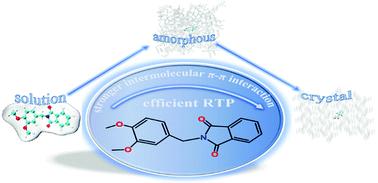当前位置:
X-MOL 学术
›
Phys. Chem. Chem. Phys.
›
论文详情
Our official English website, www.x-mol.net, welcomes your
feedback! (Note: you will need to create a separate account there.)
Unveiling the mechanisms of organic room-temperature phosphorescence in various surrounding environments: a computational study
Physical Chemistry Chemical Physics ( IF 2.9 ) Pub Date : 2021-11-11 , DOI: 10.1039/d1cp03010h Ancong Zhao 1 , Xiulan Wu 1 , Xin Jiang 1 , Jingran Gao 1 , Jian Wang 2 , Wei Shen 1
Physical Chemistry Chemical Physics ( IF 2.9 ) Pub Date : 2021-11-11 , DOI: 10.1039/d1cp03010h Ancong Zhao 1 , Xiulan Wu 1 , Xin Jiang 1 , Jingran Gao 1 , Jian Wang 2 , Wei Shen 1
Affiliation

|
Room-temperature phosphorescence (RTP) from pure organic materials has been promising in next-generation OLEDs. Understanding the photophysical properties of RTP molecules is attractive but challenging. In this study, through a combined quantum mechanics and molecular mechanics (QM/MM) method taking 2-(3,4-dimethoxybenzyl)isoindoline-1,3-dione (complex b) as an example, we comparatively investigate the photophysical properties of complex b in diverse environments (solution, crystal, and amorphous). From solution to amorphous to crystal phase, the excited-state decay rates for the molecule indicate that the AIE phenomenon of complex b is mainly induced by the increased phosphorescence rates. However, the increased nonradiative decay rate knr of T1 → S0 from the solution to the crystal phase could be attributed to the different electron coupling in the crystal phase. Moreover, the theoretical results also show that the small energy gap between the lowest singlet excited state (S1) and triplet excited state (T1) and low reorganization energy can help enhance intersystem crossing to facilitate a more competitive radiative process from the T1 state to ground state (S0). Additionally, the stronger intermolecular π–π interaction can cause high phosphorescence quantum efficiency in the crystalline phase. Our study presents a rational explanation for aggregation-induced RTP, which is beneficial for the design of new organic RTP materials in the future.
中文翻译:

揭示各种周围环境中有机室温磷光的机制:一项计算研究
来自纯有机材料的室温磷光 (RTP) 在下一代 OLED 中很有前景。了解 RTP 分子的光物理特性很有吸引力但具有挑战性。本研究以2-(3,4-二甲氧基苄基)异吲哚啉-1,3-二酮(络合物b)为例,通过量子力学和分子力学(QM/MM)相结合的方法,比较研究了其光物理性质。不同环境(溶液、晶体和非晶态)中的复合物 b。从溶液到无定形到晶相,分子的激发态衰减率表明复合物 b 的 AIE 现象主要是由磷光率增加引起的。然而,T 1 → S 0增加的非辐射衰减率k nr从溶液到晶相可归因于晶相中不同的电子耦合。此外,理论结果还表明,最低单重激发态(S 1)和三重激发态(T 1)之间的小能隙和低重组能有助于增强系统间交叉,促进来自 T 1的更具竞争力的辐射过程。态到基态 (S 0 )。此外,更强的分子间 π-π 相互作用可以导致结晶相中的高磷光量子效率。我们的研究为聚集诱导的 RTP 提供了合理的解释,这有利于未来新型有机 RTP 材料的设计。
更新日期:2021-11-24
中文翻译:

揭示各种周围环境中有机室温磷光的机制:一项计算研究
来自纯有机材料的室温磷光 (RTP) 在下一代 OLED 中很有前景。了解 RTP 分子的光物理特性很有吸引力但具有挑战性。本研究以2-(3,4-二甲氧基苄基)异吲哚啉-1,3-二酮(络合物b)为例,通过量子力学和分子力学(QM/MM)相结合的方法,比较研究了其光物理性质。不同环境(溶液、晶体和非晶态)中的复合物 b。从溶液到无定形到晶相,分子的激发态衰减率表明复合物 b 的 AIE 现象主要是由磷光率增加引起的。然而,T 1 → S 0增加的非辐射衰减率k nr从溶液到晶相可归因于晶相中不同的电子耦合。此外,理论结果还表明,最低单重激发态(S 1)和三重激发态(T 1)之间的小能隙和低重组能有助于增强系统间交叉,促进来自 T 1的更具竞争力的辐射过程。态到基态 (S 0 )。此外,更强的分子间 π-π 相互作用可以导致结晶相中的高磷光量子效率。我们的研究为聚集诱导的 RTP 提供了合理的解释,这有利于未来新型有机 RTP 材料的设计。











































 京公网安备 11010802027423号
京公网安备 11010802027423号